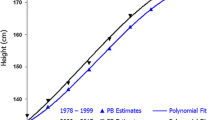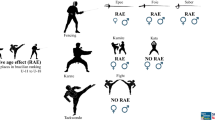Abstract
Aims
To evaluate relative age effects (RAEs) in wrestlers at the junior world championships.
Methods
Data for wrestling athletes representing 77 different countries that participated in the junior (under 21 years of age) world championships between 2006 and 2014 were collected from a publically available source. RAEs were examined among 807 female freestyle, 1205 male freestyle, and 1202 male Greco-Roman wrestlers. Athletes were sub-categorized by weight class, as medalists, and according to the number of years active in wrestling. The observed frequency of athletes per birth quarter was compared to an even quarterly distribution using χ 2 tests.
Results
No RAEs were shown for female freestyle wrestlers. For male freestyle wrestlers, RAEs were found for the overall group, the medalists, all but the extra lightweights (under 50/55 kg), and both the least (<5 years active) and moderately (5–7 years active) experienced. For male Greco-Roman wrestlers, RAEs were shown for the overall group, the middle (under 74/84 kg) and heavy weights (under 96/120 kg), and only the moderately experienced (5–7 years active).
Conclusions
Despite weight categorization, junior male wrestlers are susceptible to RAEs; however, effects in the lightest and most experienced athletes may be diminished. Differences across weight categories appear to convey different trends between the male freestyle and Greco-Roman athletes. Thus, sporting organizations, training staff, and others interested in the welfare of athletes should consider the potential impact of RAEs in wrestling.



Similar content being viewed by others
References
Cobley S, Baker J, Wattie N, McKenna J (2009) Annual age-grouping and athlete development: a meta-analytical review of relative age effects in sport. Sports Med 39:235–256
Musch J, Grondin S (2001) Unequal competition as an impediment to personal development: a review of the relative age effect in sport. Dev Rev 21:147–167
Delorme N, Chalabaev A, Raspaud M (2011) Relative age is associated with sport dropout: evidence from youth categories of French basketball. Scand J Med Sci Sports 21:120–128
Lemez S, Baker J, Horton S, Wattie N, Weir P (2014) Examining the relationship between relative age, competition level, and dropout rates in male youth ice-hockey players. Scand J Med Sci Sports 24:935–942
Gonzalez-Villora S, Pastor-Vicedo JC (2012) Relative age effect in sport: comment on Alburquerque, et al. (2012). Percept Mot Skills 115:891–894
Schorer J, Cobley S, Busch D, Brautigam H, Baker J (2009) Influences of competition level, gender, player nationality, career stage and playing position on relative age effects. Scand J Med Sci Sports 19:720–730
Gonzalez-Villora S, Pastor-Vicedo JC, Cordente D (2015) Relative age effect in UEFA championship Soccer players. J Hum Kinet 47:237–248
Garcia-Pallares J, Lopez-Gullon JM, Torres-Bonete MD, Izquierdo M (2012) Physical fitness factors to predict female Olympic wrestling performance and sex differences. J Strength Cond Res 26:794–803
Demirkan E, Kutlu M, Koz M, Ozal M, Favre M (2014) Physical fitness differences between freestyle and Greco-Roman junior wrestlers. J Hum Kinet 41:245–251
Vardar SA, Tezel S, Ozturk L, Kaya O (2007) The relationship between body composition and anaerobic performance of elite young wrestlers. J Sports Sci Med 6:34–38
Yoon J (2002) Physiological profiles of elite senior wrestlers. Sports Med 32:225–233
Goldschmied N (2011) No evidence for the relative age effect in professional women’s sports. Sports Med 41:87–88 author reply 88–90
Romann M, Fuchslocher J (2013) Influences of player nationality, playing position, and height on relative age effects at women’s under-17 FIFA World Cup. J Sports Sci 31:32–40
Baker J, Janning C, Wong H, Cobley S, Schorer J (2014) Variations in relative age effects in individual sports: skiing, figure skating and gymnastics. Eur J Sport Sci 14(Suppl 1):S183–S190
Muller L, Hildebrandt C, Raschner C (2015) The relative age effect and the influence on performance in youth alpine ski racing. J Sports Sci Med 14:16–22
Raschner C, Muller L, Hildebrandt C (2012) The role of a relative age effect in the first winter Youth Olympic Games in 2012. Br J Sports Med 46:1038–1043
Romann M, Fuchslocher J (2014) Survival and success of the relatively oldest in swiss youth skiing competition. Int J Sports Sci Coach 9:347–356
Sterkowicz-Przybycien KL, Sterkowicz S, Zarow RT (2011) Somatotype, body composition and proportionality in Polish top Greco-Roman wrestlers. J Hum Kinet 28:141–154
Garcia-Pallares J, Lopez-Gullon JM, Muriel X, Diaz A, Izquierdo M (2011) Physical fitness factors to predict male Olympic wrestling performance. Eur J Appl Physiol 111:1747–1758
Follo G (2012) A literature review of women and the martial arts: where are we right now? Sociol Compass 6:707–717
Sisjord MK, Kristiansen E (2009) Elite women wrestlers’ muscles: physical strength and a social burden. Int Rev Sociol Sport 44:231–246
Albuquerque MR, Fukuda DH, Costa VT, Lopes MC, Franchini E (2016) Do weight categories prevent athletes from the relative age effect? A meta-analysis of combat sports. Sport Sci Health 12:133–139
Albuquerque MR, Da Costa VT, Faria LO, Lopes MC, Lage GM, Sledziewski D, Szmuchrowski LA, Franchini E (2014) Weight categories do not prevent athletes from relative age effect: an analysis of Olympic Games wrestlers. Arch Budo 10:127–132
Albuquerque MR, Franchini E, Lage GM, Da Costa VT, Costa IT, Malloy-Diniz LF (2015) The relative age effect in combat sports: an analysis of Olympic judo athletes, 1964–2012. Percept Mot Skills 121:300–308
Delorme N (2014) Do weight categories prevent athletes from relative age effect? J Sports Sci 32:16–21
Fukuda DH (2015) Analysis of the relative age effect in elite youth judo athletes. Int J Sports Physiol Perform 10:1048–1051
McCarthy N, Collins D (2014) Initial identification and selection bias versus the eventual confirmation of talent: evidence for the benefits of a rocky road? J Sports Sci 32:1604–1610
Gibbs BG, Jarvis JA, Dufur MJ (2012) The rise of the underdog? The relative age effect reversal among Canadian-born NHL hockey players: a reply to Nolan and Howell. Int Rev Sociol Sport 47:644–649
Ashworth J, Heyndels B (2007) Selection bias and peer effects in team sports: the effect of age grouping on earnings of German soccer players. J Sports Econ 8:355–377
Albuquerque MR, Lage GM, Da Costa VT, Ferreira RM, Penna EM, Moraes LC, Malloy-Diniz LF (2012) Relative age effect in Olympic taekwondo athletes. Percept Mot Skills 114:461–468
Albuquerque MR, Tavares V, Lage GM, De Paula JJ, Da Costa IT, Malloy-Diniz LF (2013) Relative age effect in Olympic judo athletes: a weight category analysis. Sci Sports 28:e59–e61
Edginton R, Gibson R, Connelly C (2014) Exploring the relative age effect and nation dominance in Olympic boxing, a review of the last decade. Procedia Eng 72:805–810
Vincent J, Glamser FD (2006) Gender differences in the relative age effect among US olympic development program youth soccer players. J Sports Sci 24:405–413
Romann M, Fuchslocher J (2014) The need to consider relative age effects in women’s talent development process. Percept Mot Skills 118:651–662
Edgar S, O’Donoghue P (2005) Season of birth distribution of elite tennis players. J Sports Sci 23:1013–1020
Nakata H, Sakamoto K (2011) Relative age effect in Japanese male athletes. Percept Mot Skills 113:570–574
Camic CL, Housh TJ, Weir JP, Zuniga JM, Hendrix CR, Mielke M, Johnson GO, Housh DJ, Schmidt RJ (2010) Influences of body-size variables on age-related increases in isokinetic peak torque in young wrestlers. J Strength Cond Res 24:2358–2365
Basar S, Duzgun I, Guzel NA, Cicioğlu I, Çelik B (2014) Differences in strength, flexibility and stability in freestyle and Greco-Roman wrestlers. J Back Musculoskelet Rehabil 27:321–330
International Olympic Committee (2013) IOC Executive Board Recommends 25 Core Sports for 2020 Games. https://www.olympic.org/news/ioc-executive-board-recommends-25-core-sports-for-2020-games. Accessed 30 November 2016
International Olympic Committee (2013) 2020 Olympic Games Shortlisted International Federations Report. https://stillmed.olympic.org/Documents/Commissions_PDFfiles/Programme_commission/2020_Shortlisted_IF_Report.pdf. Accessed 30 November 2016
Author information
Authors and Affiliations
Corresponding author
Ethics declarations
Conflict of interest
The authors declare that they have no conflict of interest.
Ethical approval
The study protocol was submitted to the university’s institutional review board (ID#: SBE-15-11620) and it was determined that the research activity was not human research as defined by federal guidelines. All procedures performed were in accordance with the ethical standards of the institutional and/or national research committee and with the 1964 Helsinki declaration and its later amendments or comparable ethical standards.
Informed consent
For this type of study, formal consent is not required.
Rights and permissions
About this article
Cite this article
Fukuda, D.H., Kelly, J.D., Albuquerque, M.R. et al. Relative age effects despite weight categories in elite junior male wrestlers. Sport Sci Health 13, 99–106 (2017). https://doi.org/10.1007/s11332-017-0351-z
Received:
Accepted:
Published:
Issue Date:
DOI: https://doi.org/10.1007/s11332-017-0351-z




